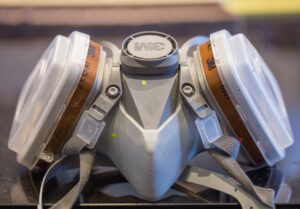
FREE March 2022 Safety Calendar
We are in a post-COVID world, and respirator use is commonplace. So, it’s important to know the basics when it comes to respirator safety.
Respirators, N95s, Masks: What’s the Difference?
Masks: Masks are NOT respirators. They don’t purify the air, and they don’t protect against COVID-19 or other viruses. General cloth or disposable face masks provide source control. That means they help prevent wearers from spreading germs or viruses to others. Surgical masks are more effective, as they provide source control and protection against germs and viruses that are transmitted via splashes or droplets. The protection surgical masks provide is limited, as small particles may still permeate the mask. Learn how to properly don and doff a facemask
N95: N95 respirators look like a mask and is worn like a mask. However, it is much more effective. An N95, when worn correctly, filters out 95% of air particles and reduces exposure to germs and viruses, including COVID-19. N95s require a seal around the face where the mask makes contact. A clean shave is recommended.
Respirators: Respirators are the masks you’ve likely seen that have either a full-face shield or cover just the nose and mouth, and two cylinders at the sides of the mouth. These types of respirators work by filtering the air and they are extremely effective when worn correctly. These are called air-purifying respirators. Another type of respirator exists that supplies breathable air. They’re called air-supply respirators. Both are reusable and require training and maintenance. Like N95s, a clean shave is required for a tight seal.
Respiratory Safety Legislation
All workplaces that fall under the designated substances regulation or that require workers to wear respirators are required to comply with:
- Control of Exposure to Biological or Chemical Agents (Reg 833/90)
- Designated Substances (Reg 490/09)
Employers must have respiratory safety programs, provide training, and perform fit testing.
Respiratory Safety Programs
Respiratory safety programs are mandatory for workplaces where respirators are used. The program must include:
- Training
- Fit testing
- Inspections
- Record keeping
- Respirator care and maintenance
- Training review and updates
Leave the training to BEST Safety Training. Respirator Safety Training | March 16th, 2022
What is Fit Testing?
Fit testing is the process used to determine if wearers can achieve and maintain a proper seal. According to the Canadian Standards Association (Z94.9.1.6), every worker using a respirator must be fit tested if they are required to wear one.
Want to have your own Respirator Fit Trainer?
Sign up for: Respirator Safety Train-the-Trainer | March 15th, 2022
Beards, Glasses, and Other Effects
The question everyone always seems to ask is: “what about my beard?” Unfortunately, if you’ve spent years growing out your best Gandalf or ZZ Top tribute beard, it’s going to have to go. A clean shave is essential to achieving the perfect seal needed for the respirator to fit correctly and protect effectively. Eyeglasses and other effects (such as hijabs or niqabs) may also impact seal. For glasses wearers, remove glasses for fit testing or achieving a seal. Once the seal is in place, glasses can be put back on. For those who wear headscarves, a seal can usually be achieved. If the scarf is obstructing the seal, the recommendation is to adjust it in a private place so that the seal area is clear.
Not Sure Where to Start? BEST Safety Training Can Help
- Learn about how Train the Trainer programs can benefit your organization!
- See all onsite and virtual learning coming soon to your area!
- Download this FREE Respirator Safety Awareness Calendar courtesy of BEST Safety Training and Consulting.
- Like the calendar? Add your email to our mailing list to get one FREE, straight to your inbox, every month. Each month features a new topic, all designed to keep your workplace safe, healthy, and compliant.
To ask questions about our training programs or to book a fit testing contact us.